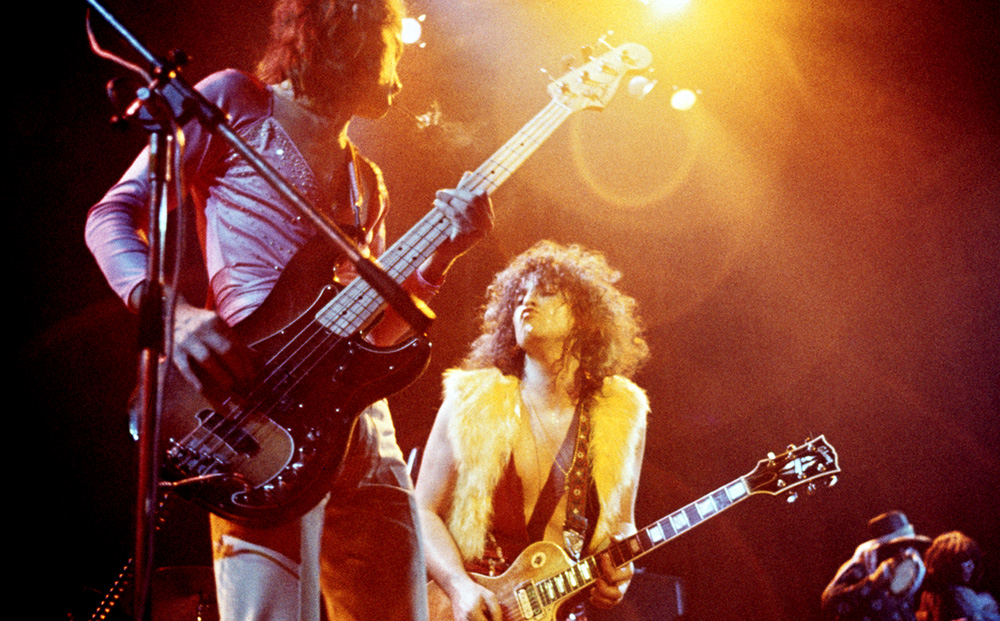“I could read a million things into each one of these lines,” Beth Orton marvels as she reels from singing a rendition of Marc Bolan’s “Hippy Gumbo” for the tribute album “Angelheaded Hipster.” “He’s just a free individual and I can just imagine what that feels like.”
Although the T-Rex frontman died tragically in a car accident far too young at the age of 29, his spirit has carried on in the four-plus decades since, with songs such as “20th Century Boy” and “Children of the Revolution” becoming enduring anthems that haven’t lost any of the electricity that Bolan first brought to them. If their continued airplay wasn’t testament enough, assembling a diverse array of artists ranging from Nick Cave, U2, Joan Jett and John Cameron Mitchell for the recording of an album of covers speaks volumes about the glam rock legend as well as how ahead of his time he was and it wasn’t lost on Ethan Silverman that their excitement about playing his music wasn’t only worth recording the audio for, but to take cameras into the studio with them.
“Angelheaded Hipster: The Songs of Marc Bolan and T-Rex” defies the traditional biopic structure to honor an artist who generally saw his identity as fluid, moving seamlessly between musical genres and gender as he and David Bowie made androgyny cool as they redefined what rock stardom was, and as contemporary artists reinterpret Bolan, the elasticity of his lyrics make it so each of the different performers can really make the songs feel personal. A poet as well as a songwriter, Bolan’s adventurous life and career is weaved throughout the performances as Elton John and Ringo Starr recall the musician who brought glitter into rock ’n’ roll and his partner Gloria Jones, who immortalized herself with the original version of “Tainted Love,” and has carried on Bolan’s legacy in establishing a music school in his name in Sierra Leone with their son Rolan.
Silverman, who has charted a similarly unconventional path as an artist as Bolan, traversing from theater and film and nonfiction and narrative drama, ends up being an ideal director for the project, teaming with the equally unconventional music producer Hal Willner, the longtime music coordinator for “Saturday Night Live” on what would be one of his final projects before his untimely passing in 2020. With “Angelheaded Hipster” now arriving at the Tribeca Film Fest for its world premiere, Silverman spoke about how he first got in tune with Bolan’s music and created a film that’s likely to please fans and make new ones, as well as bringing musicians together when so many were locked down during the pandemic.
Was the idea for an album and a film intertwined from the start or did one grow out of the other?
They came together because my producing partner Bill Curbishley had introduced the music to me for a whole other idea, and I didn’t know it that well, but then I became obsessed with it, and after living with it for two years, I had the idea to make an album, something I’d never done. But Bill’s in the music industry, so he knew more about that part, and I said, “Can we make a tribute album. We’ll get a good record producer.” And he said, “It’d be hard to raise the money for a tribute album for Marc Bolan right now.” Then a week later, I called, and said, “Well, how about if I filmed it and made a documentary?” He said, “Okay, I’ll get the money now.” And that’s how it happened.
It’s such a diversity of artists that you gather. What went into figuring out who you wanted to invite to this?
It started with Hal Willner, the record producer, because he has a very strong vision of people that he’s worked with before and people he’d like to work with, and then we had our own list of people that we knew were Marc Bolan fans, or wanted to do it, or believe it or not, a couple of people reached out to us to say, “I want to participate.” I always knew once the project started, some people would reach out to us, so it’s a combination. And it was always going to be a story about the songs and I’m somebody who’s very interested in the creative process. I know that for some people watching the creative process, watching people work in the studio, talking about the creative process can be a big bore, but I was determined to make it entertaining and interesting and emotional.
It seemed to me like some of the greatest insights actually came from an artist right after they performed, but I imagine that might not be the ideal time to do an interview. What was it like getting them to talk about the work?
It was sometimes hard because people were giving so much and then to ask them to do an interview was a lot, but the ones that did do the interviews really wanted to express themselves and how they felt. I would say I did 88% of the interviews in the film, but sometimes I was off in another room shooting something else, or I was in another city shooting something else, so once in a while I would have somebody from the crew interview everybody, but we were very clear on the areas we wanted to cover. Then after I saw a lot of footage and the movie got clearer and clearer in my mind, I would know what was missing, so I could target those interviews specifically for what we needed to say.
You also draw on a wealth of archival material to bring Marc into the picture. What was it like to dig through.
I didn’t know I was going to use quite as much archival as I ended up using. That only happened because I fell more and more in love with Marc, so I just thought, “He’s got to be the star of this.” But very early on, I wanted to weave things together in this way and nobody really thought I could do it. Bill always backed me in my vision, but as I acquired more and more material, I found a way and I knew the story I wanted to tell and I just stuck to it. And I had great, great editors in Michael Taylor and Alex Frasse who joined me on that journey and said, “We get what you want to do and we’re going to help you do it,” and they never questioned my narrative, but they made it better.
Were there any directions this took you might not have expected or epiphanies from coming through the footage?
The exploration into Tyrannosaurus Rex in the ‘60s — I knew we’d go there and that music would be very appealing to Hal. but I really did some research and made a connection that the psychedelic, folky stuff was actually related to the glam rock [era], and I’m very proud of that through line musically. But all of it’s an epiphany for me because I was discovering it from the moment I started listening to songs past “Bang a Gong” and “20th Century Boy”. Once I was doing the deep dive, it was every corner that I turned or that Hal turned really blew it open for me. The greatest moment was very, very late in the process, [but] it was when Gloria Jones, his partner, came to the project. And two things happened — one, I felt really good that I had been on the right path in talking to her about Marc and his music and then secondly, it took it to another level, both artistically and emotionally.
It actually leads to talking about the Marc Bolan Foundation in Sierra Leone where you see schoolchildren singing “Children of the Revolution.” What was that like to actually capture?
Dude, that was during the pandemic. That was sketchy WiFi, Zoom.
It looks quite sharp.
Thank you. What happened is, I’d be sitting [on Zoom with Gloria], and every so often, a little head would pop in behind her waving and saying hi. And I went, “Gloria, who are these kids? Who are these people?” [And she says] “Oh, this is so and so, and this is so and so,” and I went, “Oh, I want more of that.” And it was the furthest away two people could have been from each other making this film, but it was the closest I could have been. It was very intimate between Gloria and myself. I’m very proud of what Gloria and I did together and I hope she feels that way [at the premiere] on Friday night.
It ends up being not only a lovely tribute to Marc Bolan, but to Hal Willner as well, who sadly passed shortly after he produced this album. What was it like working with him?
It was great. It was complicated. It was intense. And thank God Hal loves film and worked on many films, many with Robert Altman and all sorts of people, so he was a huge film fan and responded well to [bringing] filmmaking into the process [because] bringing cameras into people’s workspace is not always easy. The reality of it was sometimes challenging, but he was great. He loves film. He loves people. He loves the energy of a lot of people around him.
“Angelheaded Hipster: The Songs of Marc Bolan and T-Rex” will screen at Tribeca on June 10th at 8 pm at the Indeed Theater, June 11th at 9 pm at the Cinepolis Chelsea and June 19th at 9 pm at the Village East.




